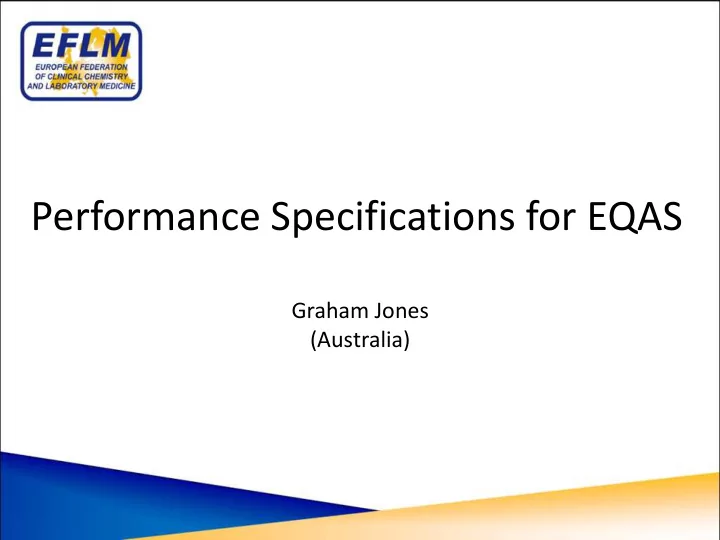

Performance Specifications for EQAS Graham Jones (Australia)
Membership • Chair: Graham Jones (AU) Graham.Jones@svha.org.au • Stéphanie Albarède (FR) steph.albarede@gmail.com • Gabriela Gutiérrez (SP) gguti@clinic.ub.es • Mauro Panteghini (IT) EFLMpresident@efcclm.eu • Marc Thelen (NL) mthelen@amphia.nl • Anne Vegard Stavelin (NO) anne.stavelin@noklus.no • Annette Thomas (UK) annette.thomas2@wales.nhs.uk • Pat Twomey (UK) taptwomey@aol.com • Emma Ventura (SP) eventura@seqc.es
External Quality Assessment • A “Pillar” of Traceability • Confirms manufacturer’s / laboratory claims • Assess – Within-laboratory performance – Between-laboratory performance • Assess: – Precision – Bias – Analytical Specificity
EQA Assessment (single Result) • Assessment: Distance from target – Target – Distance from Target • Performance Specification is used to assess distance from Target • “Defining Analytical Performance” (Milan 2014)
Aims • Apply Milan Criteria to describe EQA performance specifications • Develop common performance specifications based on Milan Criteria
EQA Performance Specifications • Currently wide variation in practice • Range between very “tight” and very “loose” • May be based on: – Statistics (State of the Art, Milan 3) – Clinical effect (Outcome or BV, Milan 1 or 2) – Other (eg regulatory, combination) • Can these be harmonised?
1. Description of Performance Specification • Minimum specification , which all reasonable laboratories would be expected to pass; • Expected specification , which most laboratories should pass but with the aim to improve those that do not meet the specification • Aspirational specification where some or many laboratories will not meet until better methods are developed. • Across this continuum, the specifications would be expected to move from looser to tighter.
Performance Specifications EQA Performance Specifications (looser) (tighter) Regulatory Aspirational (3)SAE ++ (2) Optimal BV All labs/tests pass Some tests fail
2. Expected Response • Regulatory. Laboratories should not fail. An example is the CLIA regulations in the USA. • Mandated Response . Failures require mandatory investigation involving time and effort with compliance. • Laboratory determined response. Results outside limits should be followed up, with the amount of effort depending on the nature and severity of the failure. • Industry response. If limits are too tight for current methods, the response must come from industry rather than individual laboratories.
3. Clinical Implications • Assays meet a tight specification: indicates that patients can be appropriately monitored with sequential results from different laboratories where all their assays meet this standard. • Assays meet a looser specification : monitoring may be sub-optimal, but sharing of reference intervals is supported. • Assays do not meet a loose specification: Use of common decision points not supported, separate reference intervals are required.
Assessment of current EQAS performance specifications • Surveys / other tools to: – Compare the types of EQAS performance specifications in use – Assess the information provided by EQAS providers to their customers – Identify best practice
Recommending Specifications • Consider criteria for “Common Specifications” • Consider assessment process • This should focus on “Type 1” EQA programs (Commutable material, reference measurement for target, repeated samples).
Actions • Develop terminology to describe EQA Performance Specifications • Use terminology to describe current limits • Support EQA using descriptions to communicate specifications (and meaning of specification) to clients • Consider best specifications to meet goals (May be different for different EQA programs)
Action Plan 1. Initial draft proposal circulated ~ 2 weeks ago 2. Meeting of most members tomorrow night 3. Aim for further meeting at EQALM (Bergen, October 2015)
Comments / Questions (from me) 1. We need a good relationship with EQALM 2. Should we engage other non-European EQA providers (eg CAP, CEQAL)?
Comments / Questions
Recommend
More recommend